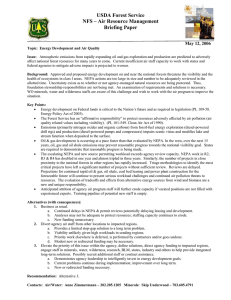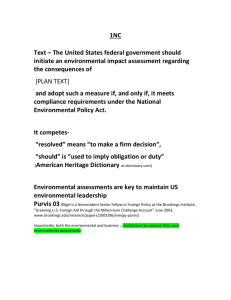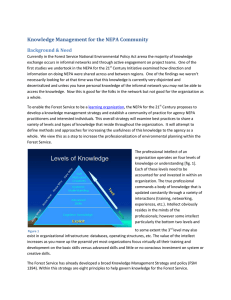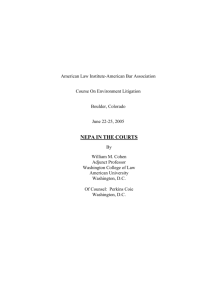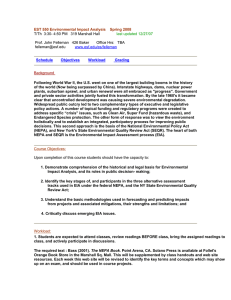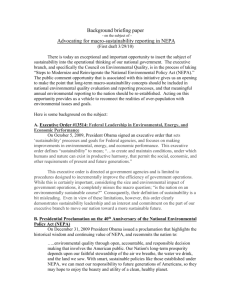ARTICLE The “Worst Case” May be the Best:
advertisement
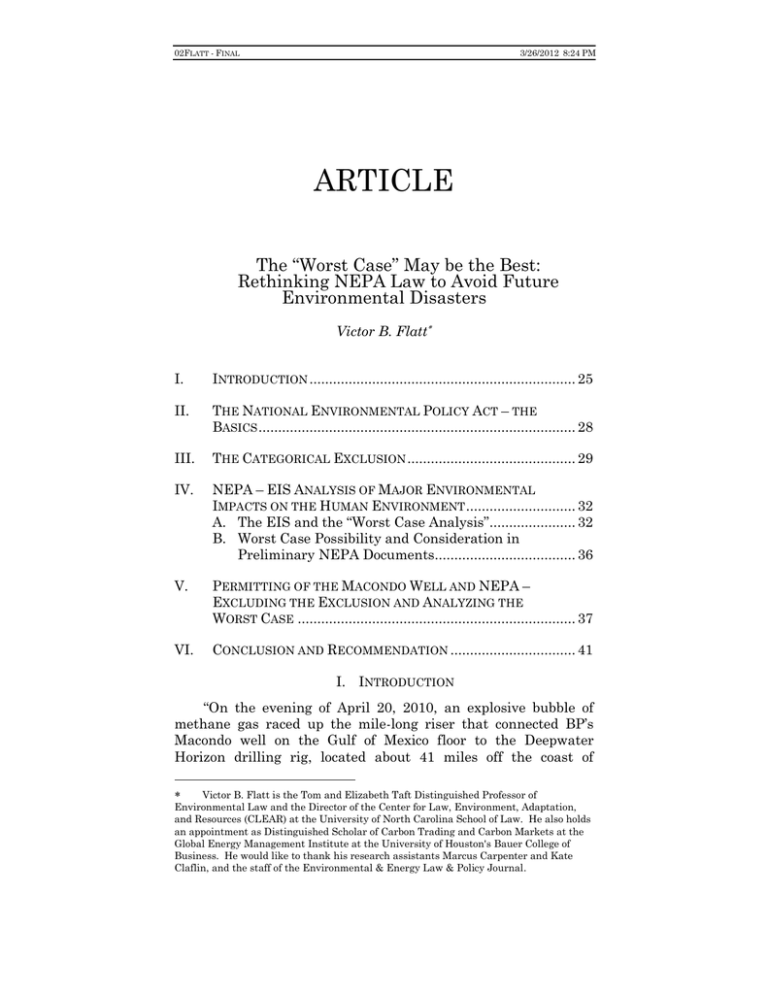
02FLATT - FINAL 3/26/2012 8:24 PM ARTICLE The “Worst Case” May be the Best: Rethinking NEPA Law to Avoid Future Environmental Disasters Victor B. Flatt I. INTRODUCTION .................................................................... 25 II. THE NATIONAL ENVIRONMENTAL POLICY ACT – THE BASICS ................................................................................. 28 III. THE CATEGORICAL EXCLUSION ........................................... 29 IV. NEPA – EIS ANALYSIS OF MAJOR ENVIRONMENTAL IMPACTS ON THE HUMAN ENVIRONMENT ............................ 32 A. The EIS and the “Worst Case Analysis”...................... 32 B. Worst Case Possibility and Consideration in Preliminary NEPA Documents.................................... 36 V. PERMITTING OF THE MACONDO WELL AND NEPA – EXCLUDING THE EXCLUSION AND ANALYZING THE WORST CASE ....................................................................... 37 VI. CONCLUSION AND RECOMMENDATION ................................ 41 I. INTRODUCTION “On the evening of April 20, 2010, an explosive bubble of methane gas raced up the mile-long riser that connected BP’s Macondo well on the Gulf of Mexico floor to the Deepwater Horizon drilling rig, located about 41 miles off the coast of Victor B. Flatt is the Tom and Elizabeth Taft Distinguished Professor of Environmental Law and the Director of the Center for Law, Environment, Adaptation, and Resources (CLEAR) at the University of North Carolina School of Law. He also holds an appointment as Distinguished Scholar of Carbon Trading and Carbon Markets at the Global Energy Management Institute at the University of Houston's Bauer College of Business. He would like to thank his research assistants Marcus Carpenter and Kate Claflin, and the staff of the Environmental & Energy Law & Policy Journal. 02FLATT - FINAL 26 3/26/2012 8:24 PM ENVIRONMENTAL & ENERGY LAW & POLICY J. [6:2 Louisiana. When it reached the top, the bubble triggered a tragic chain of events resulting in one of the largest industrial catastrophes in U.S. history. An explosion ripped through the drilling rig, killing 11 crew members and forcing 115 others – 17 of them severely injured- to quickly abandon ship….Over the next three months, before the well was finally capped on July 15, 2010, 4.9 million barrels of oil spewed into the Gulf of Mexicomaking the BP oil spill the largest accidental spill in world history.”1 Much has been written about the Macondo well oil disaster, and much remains to be written. The complete picture of what went wrong, who is to blame, and in what percentage, may never be fully agreed upon. However, on January 11, 2011, the Presidential Committee investigating the disaster issued its report, which noted that it was not an “isolated incident” that was completely unforeseen, but was caused by systemic failures of both the regulators and the private companies involved.2 As always in the case of such a huge disaster, the discussion of what went wrong with government regulation has been great.3 Both the U.S. House and Senate considered bills to change the Outer Continental Shelf Lands Act (OCSLA) to amend government practices. The version which passed the U.S. House would lift the cap on damages, have third party certification of performance requirements, improve planning for emergency response, provide greater whistleblower protections, raise civil and criminal penalties for spills, and codify the reorganization of the former Mineral Management Service (MMS), now the Bureau of Offshore Energy Management and RE (BOEMRE).4 The various Senate versions did not pass but additionally proposed adding a “worst case analysis” requirement for any exploratory or production drilling offshore.5 1. Alyson Flournoy, Sidney Shapiro, William Andreen , Thomas McGarity, James Goodwin, and CENTER FOR PROGRESSIVE REFORM, THE BP CATASTROPHE: WHEN HOBBLED LAW AND HOLLOW REGULATION LEAVE AMERICANS UNPROTECTED, CPR White Paper #1101, 1, (2011), available at http://www.progressivereform.org/articles/BP_Catastrophe _1101.pdf (last visited Mar. 31, 2011). 2. NAT’L COMMISSION ON THE BP DEEPWATER HORIZON OIL SPILL AND OFFSHORE DRILLING, DEEP WATER: THE GULF OIL DISASTER AND THE FUTURE OF OFFSHORE DRILLING, 55-93 (Jan, 2011) [hereinafter DEEPWATER COMMISSION]. 3. See e.g., Neil King, Jr. and Keith Johnson, An Oil-Thirsty America Dived Into ‘Dead Sea,’ WALL STREET JOURNAL, Oct. 9, 2010, available at http://online.wsj.com/ article/SB10001424052748704657304575540063579696700.html. 4. Consolidated Land, Energy and Aquatic Resources Act (CLEAR), H.R. 3534, 111th Cong. (as passed by House July 30, 2010). 5. See S. 3516, 111th Cong. (2010). 02FLATT - FINAL 2011] 3/26/2012 8:24 PM RETHINKING NEPA LAW 27 This “worst case analysis” requirement was in response to one of the most publicized shortcomings of the permitting of the Macondo Well, the granting of a CE from environmental analysis under the National Environmental Policy Act (NEPA).6 A CE can be used to comply with NEPA when an activity has been determined through an appropriate public process not to raise environmental concerns that would require the preparation of a more formalized study of environmental impacts.7 But according to the detailed Council on Environmental Quality (“CEQ”) report examining the disaster: As oil exploration and production moves further offshore, with an increasing number of wills [sic] drilled in deeper waters with more complex technologies and concomitant risk… the basis for a categorical exclusion for these deepwater activities needs to be reexamined in light of the increasing number of deepwater wells drilled over time.8 The granting of the CE shines a spotlight on what should have happened with the Macondo permitting under NEPA. Going forward, what role does NEPA play in preventing or mitigating the harm that results from potential catastrophic failure in an oil well blowout or something else? In 1989, in Robertson v. Methow Valley Citizens Council, the U.S. Supreme Court stated that NEPA itself did not require that an agency perform a “worst case analysis” when faced with uncertain information, even though such had previously been required administratively.9 However, the Robertson case has been misconstrued as requiring less analysis than NEPA would require for analyzing the risk of environmental disasters or the “worst case”. This paper will review the major provisions of NEPA, discuss the use of a CE, analyze what NEPA requires in considering the worst case, then discuss why the Macondo well permitting likely violated NEPA. The article then suggests how NEPA and its retained requirement for analyzing low probability/high risk environmental harms could apply to 6. 7. 8. 42 U.S.C. § 4321 et seq. (2011). 40 C.F.R. § 1508.4 (2011). COUNCIL ON ENVIRONMENTAL QUALITY, REPORT REGARDING THE MINERALS MANAGEMENT SERVICE’S NATIONAL ENVIRONMENTAL POLICY ACT POLICIES, PRACTICES, AND PROCEDURES AS THEY RELATE TO OUTER CONTINENTAL SHELF OIL AND GAS EXPLORATION AND DEVELOPMENT 30 (Aug. 16, 2010) [hereinafter CEQ REPORT] (August 16, 2010), available at http://www.whitehouse.gov/sites/default/files/microsites/ceq/ 20100816-ceq-mms-ocs-nepa.pdf. 9. 490 U.S. 332, 354 (1989). 02FLATT - FINAL 28 3/26/2012 8:24 PM ENVIRONMENTAL & ENERGY LAW & POLICY J. [6:2 permitting of deep well drilling under the OCSLA as well as other potentially high risk propositions. II. THE NATIONAL ENVIRONMENTAL POLICY ACT – THE BASICS NEPA ushered in the modern environmental age with its passage in 1969. 10 Compared to many of the later environmental laws, which tended to focus on pollution prevention, NEPA is at once broader and also less detailed. NEPA requires that the federal government “use all practicable means and measures” to protect environmental values,11 and creates the CEQ to coordinate and implement NEPA.12 But by far the most important NEPA provision has turned out to be a procedural one—the requirement that: “all agencies of the Federal Government shall…include in every recommendation or report on proposals for major federal actions significantly affecting the quality of the human environment, a detailed statement…on the environmental impact of the proposed action.”13 The document prepared pursuant to this provision is known as an Environmental Impact Statement (“EIS”).14 The determination of whether or not an EIS is required for any given action gives rise to what is known as the NEPA process, which examines the application of the statute to an action, and then determines whether that action triggers the EIS provision.15 Federal actions include federally sponsored projects, projects that are federally funded, and private projects that require federal approval or the granting of a federal permit.16 In Calvert Cliffs’ Coordinating Committee, Inc. v. U.S. Atomic Energy Commission,17 the D.C. Circuit summarized the goals of the NEPA process as follows: “The sort of consideration of environmental values which NEPA compels is clarified in Section 102(2)(A) and (B). In general, agencies must use a ‘systematic, interdisciplinary approach’ to all environmental planning and evaluation in 10. JOHNSTON, FUNK, AND FLATT, LEGAL PROTECTION OF THE ENVIRONMENT 113 (3d ed. 2010). 11. § 101, 42 U.S.C. § 4331 (2011). 12. § 202, 42 U.S.C. § 4342 (2011). 13. § 102, 42 U.S.C. § 4332(2)(C)(i) (2011). 14. JOHNSTON, ET AL., supra note 10 at 114. 15. Id. 16. See id. at 124. 17. 449 F.2d 1109 (D.C. Cir. 1971). 02FLATT - FINAL 2011] 3/26/2012 8:24 PM RETHINKING NEPA LAW 29 decisionmaking which may have an impact on man’s environment. In order to include all possible environmental factors in the decisional equality, agencies must identify and develop methods and procedures…which will insure that presently unquantified environmental amenities and values may be given appropriate consideration in decisionmaking along with economic and technical considerations.”18 NEPA may not be applicable to an agency’s action if the requirement is repealed either by explicit or implicit action of other law. In 2003, for instance, the Healthy Forests Initiative exempted certain significant logging projects from NEPA.19 With respect to implicit repeal, NEPA may also not apply if its application is made impossible by other circumstances, specifically a circumstance that legally limits an agency’s discretion in taking an action. If no discretion is allowed to consider whether or not an action can be taken, the provision of environmental information will be of no import to that action. According to Department of Transportation v. Public Citizen: “…[I]nherent in NEPA and its implementing regulations is a ‘rule of reason’ which ensures that agencies determine whether and to what extent to prepare an EIS based on the usefulness of any new potential information to the decisionmaking process. Where the preparation of an EIS would serve ‘no purpose’ in light of NEPA’s regulatory scheme as a whole, no rule of reason worthy of that title would require an agency to prepare an EIS.”20 If NEPA is not explicitly or implicitly repealed, it applies to all agency action. In such cases, the relevant “action agency” (the agency that is undertaking an action), must determine whether an EIS is required.21 III. THE CATEGORICAL EXCLUSION While the determination of whether an EIS must be prepared would normally require at least minimal analysis of environmental impacts, in the form of an environmental assessment or some other analysis, the CEQ has further 18. 19. 20. 21. Id. at 1113. 16 U.S.C. § 6513(c) (2011). 541 U.S. 752, 767 (2004). JOHNSTON, ET AL., supra note 11 at 114. 02FLATT - FINAL 30 3/26/2012 8:24 PM ENVIRONMENTAL & ENERGY LAW & POLICY J. [6:2 streamlined this process by allowing agencies to create “Categorical Exclusions” from the environmental analysis requirements.22 Action agencies may make categorical determinations that certain actions they take, particularly routine actions, will never rise to the level of an action that will significantly affect the quality of the human environment 23 These administrative determinations are known as “Categorical Exclusions” and are usually adopted through the notice and comment process.24 According to CEQ rules, a CE cannot be used when there are “extraordinary circumstances” associated with the action that would indicate the possibility of an environmental impact that should be examined.25 The use of CEs has increased in the last few years, partially as a policy choice of the CEQ.26 With the increasing use of CEs, courts have had occasion to rule on whether or not an action was “extraordinary” and thus improperly categorized under the CE.27 For instance, in 2002, the Forest Service’s decision to permit a large gathering in an Oregon national forest was held to have violated its adopted CE rules because it was extraordinary.28 It is also possible for a CE to be incorrect - that is that a type of action might actually be of a type that might have significant impacts on the human environment, but not be “extraordinary” in the CE defined by an agency’s rulemaking. Nevertheless, a failure in NEPA rulemaking for CEs may be immune from later challenge in specific instances due to prudential concerns.29 While it seems that agency action administratively allowed but contrary to law could still be challenged as such, failure to challenge a rule’s scope in the administrative timetable set out by the Administrative Procedures Act could possibly bar later challenges in a specific application. 22. 40 C.F.R. § 1508.4 (2011). 23. Id. 24. Id. 25. Id. 26. Kevin H. Moriarty, Circumventing the National Environmental Policy Act: Agency Abuse of the Categorical Exclusion, 79 N.Y.U. L. REV. 2312, 2327 (2004). 27. Riverhawks v. Zepeda, 228 F. Supp. 2d 1173 (D. Or. 2002). 28. Id. at 1189. 29. See GARY LAWSON, FEDERAL ADMINISTRATIVE LAW 912 (4th ed. 2007) (referring to possible bars to judicial review due to the ripeness, exhaustion, and finality doctrines, along with bars due to shortened statute of limitations that were Congressionally prescribed). 02FLATT - FINAL 2011] 3/26/2012 8:24 PM RETHINKING NEPA LAW 31 In Massachusetts v. United States, 30 the First Circuit held that a Massachusetts NEPA challenge to the relicensing of a nuclear power plant based on concerns regarding the storage of spent nuclear material was barred because the issue had been “globally” determined under an agency specific “general” rulemaking.31 If, as Massachusetts claimed, new information about environmental effects of spent fuel storage and risk due to terrorism now existed, the proper forum for consideration of that was a petition to re-open or undergo another general rulemaking on the matter.32 The court also noted that a challenge could be made based on differing individual circumstances, but not as a general matter.33 In other words, the court regarded the specific license challenge as a collateral attack on the rulemaking that was not allowed.34 The comparison of the situation in this case to a CE rulemaking is striking and suggests that challenges to individual activities or licenses within a CE based on problems with the CE itself may be barred. In both situations, the agencies are rulemaking on NEPA applications in a categorical manner. Both situations also recognize exceptions from the scope of the rulemaking categories of consideration, the CE in its “exceptional circumstances” language.35 Thus, while CEs may be an important tool for the volume of actions that agencies must address, if incorrectly promulgated, they could exempt whole categories of activities whose environmental impacts should be considered. In particular, largely drawn categories could create situations wherein even new knowledge of risk or new ways of meeting the category would not allow environmental consideration in particular circumstances, though NEPA would ostensibly require it by statute. 30. 522 F.3d. 115 (1st Cir. 2008). 31. Id. at 120. 32. Id. at 120-21 (citing 61 Fed. Reg. 28,467, 28,470 (June 5, 1996) (codified at 10 C.F.R. § 51)). 33. d. at 121. 34. LAWSON, supra note 30, at 912. 35. Courts have held that the Clean Water Act and Clean Air Act citizen’s suit provisions do allow a challenge after final EPA action on individual permits, without it constituting an illegal collateral attack on the original agency action. Assoc. to Protect Hommersley, Eld, and Totten Inlets v. Taylor Res., 299 F.3d 1007, 1012 (9th Cir. 2002) (pertaining to Clean Water Act); Sierra Club v. Portland Gen. Elec. Co., 663 F. Supp. 2d 983, 996-97 (D. Or. 2009) (pertaining to Clean Air Act). 02FLATT - FINAL 32 3/26/2012 8:24 PM ENVIRONMENTAL & ENERGY LAW & POLICY J. [6:2 Assuming for the moment that anything that constitutes a major action that will significantly affect the human environment is properly categorized, the question becomes what kind of analysis an agency must conduct under NEPA. In particular, what must be done in the face of potentially unknown environmental harms that can result from disasters such as the Macondo Well blowout? Can enough procedure be required to change agency permitting to avert an environmental disaster? IV. NEPA – EIS ANALYSIS OF MAJOR ENVIRONMENTAL IMPACTS ON THE HUMAN ENVIRONMENT A. The EIS and the “Worst Case Analysis” The EIS requirement is considered “procedural” as opposed to “substantive” in that it does not require an agency to select the most environmentally beneficial action.36 Nevertheless, the EIS serves to: “ensure that the agency, in reaching its decision, will have available, and will carefully consider, detailed information concerning significant environmental impacts; it also guarantees that the relevant information will be made available to the larger audience that may also play a role in both the decision-making process and the implementation of that decision.”37 Moreover, while NEPA would not require an agency to select the most environmentally beneficial choice, any substantive action taken by an agency cannot be arbitrary and capricious, and the information gleaned in an EIS might affect that determination.38 Thus in both analyzing the need for an EIS and in the EIS itself, NEPA requires the “action agency” to “consider the probabilities of the occurrence of any environmental effects it discusses.”39 In the Robertson case, plaintiffs argued that the Forest Service’s EIS was inadequate because it did not do a “worst case analysis” on the impacts of the action on the Washington State 36. Robertson v. Methow Valley Citizens Council, 490 U.S. 332, 350 (1989) (citing Stryker’s Bay Neighborhood Council, Inc. v. Karlen, 444 U.S. 223, 227-28 (1980)). 37. Id. at 349. 38. Cf. Calvert Cliffs, 449 F.2d at 1115 (substantive decision not reversible “unless it be shown that the actual balance of costs and benefits that was struck was arbitrary or clearly gave insufficient weight to environmental values”). 39. Robertson, 490 U.S. at 355 (citing Sierra Club v. Sigler, 695 F.2d 957 (1983)). 02FLATT - FINAL 2011] 3/26/2012 8:24 PM RETHINKING NEPA LAW 33 mule deer herd.40 The Ninth Circuit ruled that if the agency had difficulty with obtaining adequate information on the impact of the project on the herd, then it was required to prepare a “worst case analysis” of the impacts formulated on the basis of available information.41 The Ninth Circuit appears to have been using the term “worst case analysis” to refer to prior CEQ regulation which stated that if information relevant to an agency’s decision was unavailable or too expensive to get, then the agency must include in an EIS a “worst case analysis and an indication of the probability or improbability of its occurrence.”42 The Supreme Court reversed the specific holding that a “worst case analysis” as described in the prior CEQ regulation was required in the face of uncertainty, but affirmed that NEPA did “require all agencies to describe environmental impacts in the face of substantial uncertainty.”43 This includes a consideration of the “probabilities” of any environmental effect that it discusses.44 A close reading of the court’s opinion in Robertson indicates that the rejection of the CEQ “worst case analysis” does not require less attention or necessarily different attention to uncertain environmental impacts. To the extent that an environmental impact is known, no matter its improbability, it should still be examined; to the extent it is unknown, it could not be analyzed under a “worst case analysis” in any event. Nevertheless, the agencies themselves, as well as commentators, seemed to treat this part of Robertson as a repudiation of such an analysis. For example, the Ninth Circuit simply cited Robertson without further explanation in noting that “NEPA does not require a worst case analysis.” 45 As Oliver Houck noted in his initial examination of NEPA and the Macondo oil well blowout: “worst case was out and a more generalized impact description was in.” 46 40. Id. at 354. 41. Methow Valley Citizens Council v. Reg’l Forester, 833 F.2d 810, 817 (9th Cir. 1987) (quoting Save our Ecosystems v. Clark, 747 F.2d 1240, 1244-5 (9th Cir. 1984)). 42. 40 C.F.R. § 1502.22 (1985). 43. Robertson, 490 U.S. at 355 (citing 51 Fed. Reg. 15,603, 15,625 (April 25, 1986) (codified at 40 C.F.R. § 1502.22)). 44. Id. (citing Sierra Club v. Sigler, 695 F.2d 957 (1983)). 45. Edwardsen v. United States Dep't of the Interior, 268 F.3d 781, 785 (9th Cir. 2001). 46. Oliver Houck, Worst Case and the Deepwater Horizon Blowout: There Ought to Be a Law, 24 TUL. ENVTL. L. J. 1, 14 (2010). 02FLATT - FINAL 34 3/26/2012 8:24 PM ENVIRONMENTAL & ENERGY LAW & POLICY J. [6:2 As a descriptive matter, Professor Houck is obviously correct. A review of the NEPA procedures followed in the permitting of the Macondo Well demonstrates that the remote but real possibility of environmental harm from an uncontrolled well blowout was not examined properly.47 As a legal matter, however, I propose that Robertson really did not signal a significant change, and that a recognition of this would reinvigorate consideration of risky environmental actions, without the need for additional legislative or regulatory requirements. As Professor Bill Rodgers notes: “Dinah Bear reminds me that the ‘reasonably foreseeable’ information that can be discussed in NEPA documents ‘includes impacts which have catastrophic consequences, even if their probability of occurrence is low, provided that the analysis of the impacts is supported by credible scientific evidence, is not based on pure conjecture, and is within the rule of reason.’”48 When addressing the question in a detailed analysis, the Ninth Circuit is in accord with this understanding of NEPA. In San Luis Obispo Mothers for Peace v. the Nuclear Regulatory Commission,49 the court stated that: “No provision of NEPA, or any other authority cited by the Commission, allows the NRC to eliminate a possible environmental consequence from analysis by labeling the risk as “unquantifiable.” See Limerick Ecology Action, Inc. v. NRC, 869 F.2d 719, 754 (3rd Cir.1989) (J. Scirica, dissenting) (finding no “statutory provision, no NRC regulation or policy statement, and no case law that permits the NRC to ignore any risk found to be unquantifiable”). If the risk of a terrorist attack is not insignificant, then NEPA obligates the NRC to take a “hard look” at the environmental consequences of that risk. The 47. DEEPWATER COMMISSION, supra note 2, at 82; see also CENTER FOR OCEAN SOLUTIONS, THE NATIONAL ENVIRONMENTAL POLICY ACT (NEPA) AND A REVIEW OF MMS NEPA DOCUMENTS 21 (Oct. 19, 2010) [hereinafter “COS WHITE PAPER”] (prepared for the National Commission on BP Deepwater Horizon Oil Spill and Offshore Drilling) (“MMS appears to have skirted any real “worst case analysis” in its NEPA documents”). 48. William Rodgers, NEPA’s Insatiable Optimism, 39 ENVTL. L. REP. NEWS & ANALYSIS 10618, 10623 n. 60 (2009) (quoting 40 C.F.R. § 1502.22(b)(1)). 49. San Luis Obispo Mothers for Peace v. Nuclear Regulatory Comm’n, 449 F.3d 1016, 1016 (9th Cir. 2006). 02FLATT - FINAL 2011] 3/26/2012 8:24 PM RETHINKING NEPA LAW 35 NRC's actions in other contexts reveal that the agency does not view the risk of terrorist attacks to be insignificant. Precise quantification is therefore beside the point.”50 In this case, the court emphasizes that if there is some “not insignificant” probability of an event, it is susceptible to examination for environmental effects in a NEPA context. What “not insignificant” means may be open to interpretation, but a rereading of the Robertson case with the San Luis Obispo case seems to suggest that if the agency itself recognizes it as a possibility, it should be analyzed. Professor Fitzgerald’s analysis of the history of the “worst case analysis” regulatory requirement notes that it was always difficult to follow, and that its requirement was not really distinct from the general NEPA requirement which mandates analysis of a “low probability catastrophic event.51 While the CEQ altered the “worst case” regulatory requirement to one that required the agency to prepare an analysis of risks based on scientific methods, in the final rulemaking, the CEQ itself indicated that this was not a substantive change: “It does not, however, eliminate the requirement for federal agencies to evaluate the reasonably foreseeable significant adverse impacts of an action, even in the face of unavailable or incomplete information. Rather, it specifies that the evaluation must be carefully conducted, based upon credible scientific evidence, and must consider those reasonably foreseeable significant adverse impacts which are based upon scientific evidence.”52 In accord with this understanding, the court in Robertson noted that the new rule and NEPA “retains the duty to describe the consequences of a remote, but potentially severe impact.”53 Cass Sunstein has suggested that the “worst case analysis” regulatory requirement can make a psychological difference as a framing mechanism for the public, which in turn could bring pressure to stop or halt agency activities, but this does not comport with a different legal requirement.54 50. 51. Id. at 1032. Edward R. Fitzgerald, The Rise and Fall of the Worst Case Analysis, 18 U. DAYTON L. REV. 1, 12 (1992). 52. 51 Fed. Reg. 15, 618 (Apr. 25, 1986). 53. Robertson, 490 U.S. at 354. 54. Cass Sunstein, Probability Neglect: Emotions, Worst Cases, and the Law, 112 02FLATT - FINAL 36 B. 3/26/2012 8:24 PM ENVIRONMENTAL & ENERGY LAW & POLICY J. [6:2 Worst Case Possibility and Consideration in Preliminary NEPA Documents What then is to be made of NEPA’s requirements that even unlikely events that cause environmental harm are to be analyzed under the EIS process? Does this also by definition mean that such an occurrence is also to be considered in determining whether an action will have a significant effect on the human environment at all for the environmental analysis needed to make an EIS necessity determination for purposes of triggering NEPA? The Ninth Circuit rejected the distinction between the two in the San Luis Obispo case, by noting that the probability of a terrorist attack, while low, is still of the kind of event that can be considered when triggering the EIS requirement.55 In its responses to comments in the Federal Register notice, announcing the final rule, the CEQ noted that an analysis in an EA was much less “sophisticated” than the analysis required in an EIS, and disclaimed this level of analysis in an EA,56 but that comment must be understood in the context of what goes in the EA itself, not in what must be considered in determining whether to prepare an EIS. If a severe impact, of even low probability, can be reasonably anticipated, whether or not that should be a part of an EIS must be part of the procedure to determine whether or not an EIS is required. No mention of the role of consideration of impacts in an EA was mentioned in the new rule or the one it replaced.57 Professor Joel Mintz has also suggested that NEPA’s structure and history requires this.58 He notes that since courts are to defer to statutory purposes when examining how a law is administered, NEPA’s broad calls for all agencies to practice substantive environmental protection in Section 102(a) should bolster an argument that a determination of whether an EIS is required must at least analyze the specific environmental impacts (in determining whether they are major) that would have to be considered if an EIS was required.59 YALE L.J. 61, 97 (2002). 55. 449 F.3d. at 1032. 56. 51 Fed. Reg. 15, 619 (Apr. 25, 1986). 57. 40 C.F.R. § 1502.22(b)(4). 58. Joel Mintz, Taking Congress’s Words Seriously: Towards a Sound Construction of NEPA’s Long Overlooked Interpretation Mandate, 38 ENVTL. L. 1031 (2008). 59. Id. 02FLATT - FINAL 2011] 3/26/2012 8:24 PM RETHINKING NEPA LAW 37 V. PERMITTING OF THE MACONDO WELL AND NEPA – EXCLUDING THE EXCLUSION AND ANALYZING THE WORST CASE Given the prior analysis of NEPA provisions, what should have happened before the permitting of the Macondo Well, and would it have prevented the blowout itself or at least minimized the damage from the blowout? The sequence of NEPA actions applying to the Macondo Well is as follows: 1. EA on deepwater operations in the Gulf – 200060 2. OCSLA Lease Sale 2007-2012 Programmatic EIS – 200761 3. Gulf of Mexico OCS Oil and Gas Lease Sales: 20072012 Western Planning Area Sales 204, 207, 210, 215 and 218 Central Planning Area Sales 205, 206, 208, 213, 216, and 222 Programmatic EIS-200762 4. BP Initial Exploration Plan – Categorical Exclusion 200963 5. BP’s Revised Exploration Plans for Amendment for the Macondo Well – CE - 200964 6. BP’s Application for Permit to Drill – CE 15.4C(12)– May 2009, January 25, 2010, March 15, 2010, April 15, 2010.65 For the March and April applications, the record of decision (ROD) indicates approval in March and April on the same day of application.66 Thus while there were NEPA analyses for the leasing of the entire area, and analyses for the original exploratory bids (again for the entire area), the individual drilling plans were never analyzed under NEPA.67 While OCSLA requires at least 60. MINERALS MANAGEMENT SERVICE, GULF OF MEXICO DEEPWATER OPERATIONS AND ACTIVITIES ENVIRONMENTAL ASSESSMENT (May 2000), available at www.gomr.mms. gov/ PDFs /2000/2000-001.pdf. 61. MINERALS MANAGEMENT SERVICE, OUTER CONTINENTAL SHELF OIL AND GAS LEASING PROGRAM: 2007-2012 FINAL ENVIRONMENTAL IMPACT STATEMENT (Apr. 2007), available at www.boemre.gov/5-year/2007-2012FEIS.htm. 62. MINERALS MANAGEMENT SERVICE, GULF OF MEXICO OCS OIL AND GAS LEASE SALES: 2007-2012 WESTERN PLANNING AREA SALES 204, 207, 210, 215, AND 218 CENTRAL PLANNING AREA SALES 205, 206, 208, 213, 216, AND 222 DRAFT ENVIRONMENTAL IMPACT STATEMENT (Nov. 2006), available at www.gomr.mms.gov/PDFs/2006/2006-062-Vol1.pdf and www.gomr.mms.gov/PDFs/2006/2006-062-Vol2.pdf. 63. CEQ Report, supra note 9, at 16 n. 26. 64. Id. 65. Id. 66. Id. 67. Id. at 24-25. 02FLATT - FINAL 38 3/26/2012 8:24 PM ENVIRONMENTAL & ENERGY LAW & POLICY J. [6:2 one EIS for operating permits for a development and production well, the OCSLA also effectively exempts western Gulf wells from such a permitting requirement by designating that western Gulf drilling does not have to apply for a development and production permit.68 The history of exploration and drilling in the western Gulf and the apparently routine nature of such drilling led to this compromise.69 This does not mean that NEPA does not apply— just that an automatic EIS requirement was dispensed with. Instead, the MMS issued the drilling permits pursuant to a CE without undergoing individual NEPA analysis.70 There is another potential obstacle to NEPA application to OCSLA leasing. By its own terms, the OCSLA requires the agency to make decisions on drilling applications in the western Gulf within 30 days, which makes it difficult to do a thorough environmental analysis.71 Indeed, it could be argued that such a timetable works as an implicit repeal of NEPA since the timetable in OCSLA limits the agency’s discretion to consider environmental impacts.72 This is why both the CEQ report examining NEPA compliance in the permitting and the Presidential Gulf Spill Commission both recommend that this timing requirement be revisited.73 However, even without a legislative change to this timetable, BOEMRE has been able to do some more intensive environmental reviews by altering the time for when the application is considered to be “submitted.”74 Whatever the requirements should have been, we have a situation where NEPA was largely on the sidelines with respect to the Macondo Well permitting.75 An examination of environmental impacts on the lease sale and the bids for the entire area were large programmatic EISs that by their terms did not (and could not) look at impacts of individual wells.76 While an EIS or an EA might arguably have been required at the point where permits for individual wells were secured (assuming that the OCSLA timing requirement did not derail NEPA), the earlier 68. DEEPWATER COMMISSION, supra note 3, at 62. 69. Id. 70. Id. at 81. 71. 43 U.S.C. § 1340(c) (Supp. 2011); see CEQ Report, supra note 9 at 8. 72. CEQ Report, supra note 9, at 32. 73. Id.; DEEPWATER COMMISSION, supra note 3, at 80. 74. This approach was suggested in a white paper prepared by the Center for Ocean Solutions. COS WHITE PAPER, supra note 48, at 24. 75. See DEEPWATER COMMISSION, supra note 3, at 81-82. 76. CEQ Report, supra note 9, at 24-25; DEEPWATER COMMISSION, supra note 3, at 84 02FLATT - FINAL 2011] 3/26/2012 8:24 PM RETHINKING NEPA LAW 39 granting of a CE for well drilling and operation stopped that from occurring.77 Essentially, for purposes of operating the Macondo Well, BP (and its partners) received a pass on NEPA, coming under the CE for offshore drilling.78 Though in hindsight, it appears that the CE category itself was flawed. Based on the case law (discussed supra) regarding the proper time to challenge administrative decision-making, it might not have been possible to challenge the category itself at the time the permits for the Macondo Well were granted. CEs can be challenged on the basis that the specific application itself was unusual for purposes of the category. Given that the original CE was put into place for all offshore well drilling before the technology existed to construct an ultra deep well such as the Macondo, it is possible that one could have challenged a NEPA CE for an ultra-deepwater well on the basis that it is substantially different from the category that was considered.79 Looking back, it seems that many of our own environmental watchdogs were asleep at the wheel, not challenging the CE for an ultra deep-water drilling permit, not petitioning for a revised rulemaking to take away the CE status for ultra-deep drilling or for floating platforms, and not fully investigating the clean-up plan that was relied upon to allow the permit under the OCSLA itself. Assuming that there were no CE for this type of activity (which is likely going forward), NEPA might have been successfully used to avert some of the Macondo Well disaster and thus should be considered an important tool for avoiding environmental disasters in the future. Without a CE, the agency would have had to ask whether the permitting would be a “major federal action significantly affecting the quality of the human environment.”80 An argument could be made that the activity qualifies as such (or at least has to be examined to make that determination) solely based on the drilling and operation of the wells.81 These are very large installations that have an important effect on the coastal 77. 78. 79. 80. 81. CEQ Report, supra note 9, at 24-25. See DEEPWATER COMMISSION, supra note 3, at 82-84. Id. at 83. NEPA § 102, 42 U.S.C. § 4332(2)(c)(i). DEEPWATER COMMISSION, supra note 3, at 83. 02FLATT - FINAL 40 3/26/2012 8:24 PM ENVIRONMENTAL & ENERGY LAW & POLICY J. [6:2 economy and the mere use of non-water based hydraulic fluid can contaminate the water.82 When the concerns about a possible spill and clean-up come into play, it seems that an EIS (or at least a substantial EA) would be required. While the drilling companies maintained that a blowout was very unlikely and that they had failsafe plans for cleaning up a disaster, to the extent that a blowout is reasonably foreseeable, it appears that it must be examined, at least under an EA. The case law analysis from Robertson indicates that if it is reasonably foreseeable, the impacts should be analyzed. Since a blowout is reasonably foreseeable, the environmental impacts of such, and how to prevent it, become required analysis. Once such a requirement is in place, it becomes plausible to see how this analysis would have lessened the impact of the blowout. A study of the possibility of a blowout would have focused on the blowout preventer, in this case the blind-shear ram. There was already evidence that back-up shears were much more likely to work than a single shear only.83 The MMS had commissioned tests that indicated a 50% failure rate of single shears, but no failure rate of double shears.84 This is because with double shears, the spacing can always be such that both of the shears will never attach at a weakened point along the pipeline to the ocean floor.85 BP chose not to use double shears.86 If there had been an environmental analysis, it could be argued that the failure of MMS to require such shears before granting the permit would have been arbitrary and capricious, and thus a violation of the APA.87 The cost of such shears was not exorbitant, and the failure rate was hugely different – just the kind of information that when put in a record would powerfully dictate an agency outcome. 82. Id. 83. David Barstow et al., Regulators Failed to Address Risks on Oil Rig Fail-Safe Device, N.Y. TIMES, June 20, 2010, available at http://www.nytimes.com/2010/06/21/us/ 21blowout.html; WEST Engineering Services, Shear Ram Capabilities Study 3-5-3-6 (Sept. 2004), available at http://www.boemre.gov/tarprojects/463/%28463%29%20West% 20Engineering%20Final%20Report.pdf (prepared for the Minerals Management Service). 84. Barstow et al., supra note 84. 85. Id. 86. DEEPWATER COMMISSION, supra note 3, at 93; see also Barstow et. al, supra note 84. 87. 5 U.S.C. § 706 (Supp. 2011). 02FLATT - FINAL 3/26/2012 8:24 PM 2011] RETHINKING NEPA LAW VI. 41 CONCLUSION AND RECOMMENDATION The Macondo well blowout may never have happened if the NEPA had been correctly applied to the MMS permitting activity on the Gulf. Absent the CE for such drilling, which should never have been granted administratively, a close reading of Robertson indicates that the environmental impacts of all reasonably foreseeable events should be examined. Had that been the case here, the much more effective redundant blow-out preventers would have clearly been cost effective in minimizing safety and environmental risks. So what are the lessons learned and how do they apply to avoiding future environmental disasters? Probably the most important lesson is that the environmental community has not been alert to the potential of using NEPA to avoid potential low probability, high impact disasters. This comes from the almost uniform misreading of the Robertson court’s rejection of the Ninth Circuit’s “worst case analysis” requirement. In addition, it seems that we should all be doing a better job of applying what is required in NEPA. Certainly the MMS fell flat on this occasion, giving in to the business as usual, and accommodating the fast pace of permitting in the western Gulf, without seriously examining potential dangers. Such “agency capture” may exist now or in the future at other regulatory agencies. This means that the public, in the form of citizens’ groups should use the legal requirements in NEPA to challenge such lax regulation. CEs have grown in use over the last few years and should be reexamined at all agencies.88 If the agencies themselves do not correct problematic CEs, then the public can by petitioning for new rulemakings.89 Moreover, the public will also have to be the one to look at licensing and permitting of activities to ensure that risky impacts are considered. Even if the companies operating in the western Gulf asserted that the probability of a blow-out was low, the fact that NEPA analysis was required of drilling outside of this area and the fact that environmental groups have for years been decrying the expansion of offshore drilling, indicates that this risk is not a surprise. Similarly, in other agencies, risks of operation should be examined and when they are reasonably foreseeable and can have a major impact on the human environment, lawsuits should force the application of NEPA. 88. 89. DEEPWATER COMMISSION, supra note 3, at 81-82. See supra discussion accompanying notes 19. 02FLATT - FINAL 42 3/26/2012 8:24 PM ENVIRONMENTAL & ENERGY LAW & POLICY J. [6:2 Perhaps if we utilize the provisions of NEPA, and in particular focus on the requirement that even low probability events must be analyzed if there is any reasonable probability of occurrence, we might avoid a future Deepwater Horizon blowout. By using NEPA’s worst case, we might end up with the best case of avoiding such future disasters.
